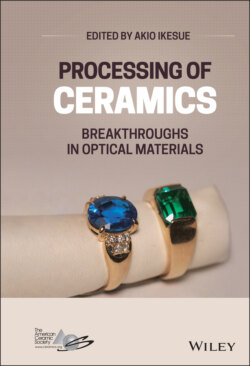Читать книгу Processing of Ceramics - Группа авторов - Страница 25
2.3.4 Other Materials (CaF2, Pseudo Perovskite, ZnSe, ZnS, etc.)
ОглавлениеIn Section 2.3.2 and 2.3.3, garnet and sesquioxide ceramics lasers are described. Other oxides and non‐oxide materials related to laser application are described in this section.
Figure 2.13 (a) Absorption and emission spectrum of Er:Sc2O3 ceramics.
Source: Ter‐ Gabrielyan et al. [11].
(b) schematic setup of laser oscillator using cryostat, and (c) laser performance of Er:Sc2O3 ceramics.
Tanaka et al. focused on the perovskite structure, BMT (Ba(Mg,Ta)O3) [12]. This material is a perovskite structure (tetragonal crystal system) and includes birefringence; hence, it cannot be applied to laser from this technical viewpoint. When an appropriate amount of Zr is added to this material, it becomes a cubic BMZT (Ba(MgZrTa)O3). Therefore, the idea is that if a highly transparent material could be synthesized, it could be used as a laser material. When Nd is added to this transparent material, there are three light emission lines associated with f‐f electron transition in Nd electrons; (i) 4F3/2 ⇒ 4I9/2(0.9 μm), (ii) 4F3/2 ⇒ 4I11/2(1,0 μm), and (iii) 4F3/2 ⇒ 4I13/2(1.3 μm), which can be amplified to generate a laser. This material becomes disordered by introducing multiple ions into the B site of the perovskite basic structure ABO3 and causes broadening of emission spectrum. Figure 2.14a shows the external view and microstructure of the BMZT ceramics. Figure 2.14b and c show the cw laser performance, and the oscillation spectrum obtained from the Nd:BMZT ceramics, respectively. Although it oscillates almost in a single mode, its slope efficiency is as low as approximately 5%.
Figure 2.14 (a) Appearance and microstructure, (b) cw laser performance, and (c) oscillation spectrum of BMZT ceramics.
Source: Kaminskii et al. [12]© 2009, John Wiley & Sons.
Sarthou et al. synthesized Yb:CaF2 powders having a particle diameter of about 30 nm by a wet method, and a dense sintered body was obtained with this raw material powder by hot press method [13]. As shown in Figure 2.15a, although the optical loss of the prepared 2%Yb:CaF2 ceramics in the visible to the ultraviolet region is large, it reaches near the theoretical transmittance (T = 93%) in the 1 μm region. Aballea et al. also synthesized transparent 4%Yb:CaF2 ceramics and succeeded in laser oscillation [14]. But this ceramic has remarkable scattering in a wavelength range shorter than 600 nm as seen in Figure 2.15b. The lasing efficiency curves of a 4%‐doped Yb:CaF2 ceramic and a 4.5% Yb:CaF2 single crystal are compared in Figure 2.15c. Since the lasing efficiency of ceramics (57.9%) is lower than that of the corresponding single crystal (79.2%), it is still necessary to improve optical performances of these ceramics. The maximum output reached approximately 1.5 W, and wide tunability of laser oscillation has been confirmed in this material. The future results of CaF2 ceramics are being expected.
Kitajima et al. also synthesized Yb:CaF2 ceramics and succeeded in generating 184 fs ultrashort pulses using a mode‐locked laser system [15]. Since the output is 300 mW at 10.1 W pump power (wavelength λ = 975 nm), the efficiency is not high. When Nd is added to CaF2, generally Nd agglomeration occurs and it induces a reduction in a lifetime, and hence laser oscillation could not achieve in the past. However, Chen et al. developed transparent Nd:CaF2 ceramics doped with YF3 and LaF3 and succeeded in laser oscillation [16]. The dependence of the average output power on the absorbed pump power under quasi‐cw pumping is shown in Figure 2.16. Although the slope efficiency during cw laser oscillation is only 2%, they successfully got a breakthrough on the problems of doping Nd to CaF2 material.
Figure 2.15 (a) Optical transmission of 2%Yb:CaF2 transparent ceramics window in comparison with that of non‐doped CaF2 single crystal.
Source: Sarthou [13].© 2016, John Wiley & Sons.
(b) Room temperature scattering coefficient of a 4 at.%‐doped Yb:CaF2 ceramic. (c) Comparison between the lasing efficiency curves of a 4%‐doped Yb:CaF2 ceramic and a 4.5% Yb:CaF2 single crystal versus absorbed pump power neglecting saturation effects.
Source: Aballea et al. [14]© 2015, The Optical Society.
Non‐oxide and compound (II‐IV) materials are described in the following. Mirov et al. reported the Cr2+:ZnSe and Fe2+:ZnSe ceramics [17]. After mixing CrSe (or FeSe) and ZnSe powder, the mixture is pressed by HP (hot pressing machine) at 1400–1500 K and a high pressure of 350 MPa to obtain a dense and transparent material. Figure 2.17 shows an appearance of Cr:ZnSe and Fe:ZnSe ceramics produced by the HP and a reference Fe:ZnSe single crystal.
In Figure 2.18a and b, the absorption and emission spectra of Cr‐doped ZnSe, ZnS, and CdSe, and Fe‐doped ZnSe and CdMnTe are shown, respectively. As seen in these figures, the Cr2+ and Fe2+ ions have very broad absorption and emission spectra in the II–VI host materials. Normally, oxide host materials doped with rare earth elements cannot provide such spectroscopic properties. Therefore, these II–VI host materials are very important for the development of tunable lasers over a broad mid‐infrared spectral range. They achieved 2 mJ output in pulse operation and 250 mW output in CW operation using these fabricated ceramics. In addition, an output of 150 mW was achieved in single‐mode oscillation. A high‐quality Cr:ZnSe crystal was tested for CW operation, using an Er: glass fiber (1.5 μm) laser as an excitation source. A high slope efficiency (43%) and maximum output power of 12.5 W (incident power of 29 W) were achieved. Therefore, the production of high‐quality ceramic laser materials and power scaling will be challenging problems in the future.
Figure 2.16 Dependence of the average output power on the absorbed pump power under quasi‐cw pumping.
Source: Chen et al. [16].
Figure 2.17 Appearance of Cr‐doped ZnSe, and Fe‐doped ZnSe ceramics by hot press and Fe:ZnSe single crystal as reference.
Source: Mirov et al. [17].
Figure 2.18 Absorption and fluorescence spectra of (a) Cr‐doped ZnSe, ZnS, and CdSe and (b) Fe‐doped ZnSe and CdMnTe.
Source: Modified from [17].
